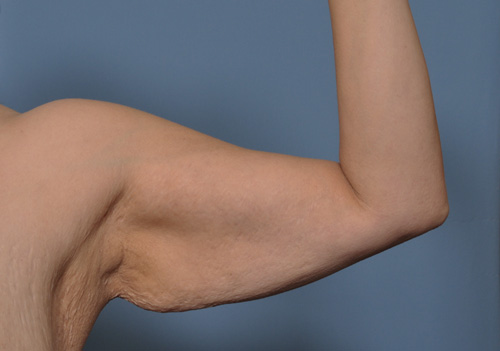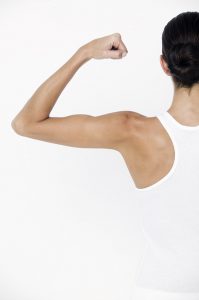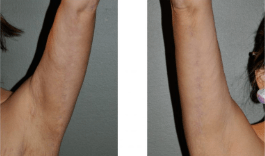Arm Lift
Arm Lift Surgery Dr. Barry L. Eppley
Dr. Barry L. Eppley is an experienced Indianapolis plastic surgeon who has helped numerous armlift patients reduce the amount of skin and stubborn fat deposits in the upper arm area. Please read the information below and visit the arm lift results page to see the outcomes of several of his patients.
 Unhappiness with the appearance of one’s upper arms is a reflection of how much skin and fat exists on the back of the arm. When the hanging of the back of the upper arm is not considerable, then too much fat may be the primary problem which can be addressed by liposuction. Different types of liposuction are available (Power-Assisted Liposuction is my current prference) but, despite many marketing claims, no form of liposuction has been proven to produce superior tightening effects over others. While many women think that liposuction will solve their upper arm concerns, they usually give too much credit to the limited skin tightening that liposuction can do. More often than not, excess skin as well as fat is the problem and both must be addressed through armlift surgery if considerable reduction in the circumference of the upper arm is to be achieved.
Unhappiness with the appearance of one’s upper arms is a reflection of how much skin and fat exists on the back of the arm. When the hanging of the back of the upper arm is not considerable, then too much fat may be the primary problem which can be addressed by liposuction. Different types of liposuction are available (Power-Assisted Liposuction is my current prference) but, despite many marketing claims, no form of liposuction has been proven to produce superior tightening effects over others. While many women think that liposuction will solve their upper arm concerns, they usually give too much credit to the limited skin tightening that liposuction can do. More often than not, excess skin as well as fat is the problem and both must be addressed through armlift surgery if considerable reduction in the circumference of the upper arm is to be achieved.
WILL EXERCISE TONE MY SAGGING ARMS?
 While there is no denying the benefit of exercise for any body area, no amount of diet or exercising is going to remove excess fat or loose skin on the arms. Exercise builds up the muscles which lies deep to the fat and skin. Making these muscles bigger or more toned will not make what lies on top of them go away, particularly on the back (triceps) of the arms.
While there is no denying the benefit of exercise for any body area, no amount of diet or exercising is going to remove excess fat or loose skin on the arms. Exercise builds up the muscles which lies deep to the fat and skin. Making these muscles bigger or more toned will not make what lies on top of them go away, particularly on the back (triceps) of the arms.
LIPOSUCTION vs. ARMLIFT
The biggest decision in arm reshaping is to make the determination of whether liposuction alone or a formal armlift is needed. An armlift always produce the best upper arm reshaping but it does so at the price of a long arm scar. Understandably this is a major concern for most women and that decision must be considered carefully. If a scar is unacceptable due to a smaller upper arm problem, then liposuction is the only option. While it may not produce a patient’s optimal result in many cases, at least there is no scar trade-off.
Sagging of the upper arm skin is usually the result of considerable weight loss for most women, particularly after bariatric surgery where weight losses may approximate 75 lbs or more. They are often referred to as ‘bat wings’ due to their sagging appearance and size. It is not only a cosmetic problem, but can pose functional problems such as difficulty with fitting of shirts and blouses and skin irritation under the armpit and along the side of the breast. Because it is primarily composed of skin, no amount of exercise will ‘tighten the arms’ or make them look smaller. Arm lift surgery is the only method of reshaping (reducing the circumference) of the upper arm in these more severe cases.
ARMLIFT INCISIONS
While arm lift surgery produces a long scar, there are two locations for it on the inside of the arms. The traditional arm lift cuts out the tissue on the inside or medial surface of the arm between the armpit and the elbow. This means that it can not be seen from behind but may be seen if one raises their arms. While effective it has been my experience that the inner arm scar often becomes wide or hypertrophic and can be slow to heal. This is not my preferred armlift technique and is no longer used.

The more ideal place for an armlift scar is almost on the back of the arm, roughly halfway between the inside and the backside of the arm. This scar is not seen when one raises their arms but may be seen from behind. The tissue quality in this part of the arm allows it to heal better and produce more favorable scars. In addition, more upper arm tissue can be removed and a better circumferential arm reduction is achieved.

In some cases of very sagging arms, the tissue excision will need to extend into and past the armpit and down along the sides of the chest. This is often the case in the bariatric surgery patient where a lot of loose body skin has resulted from the weight loss.
Armlift – Before Surgery

Examination of the arms will determine which technique, arm lift or liposuction, would be most effective. It is very important that the patient understands the location and length of the resultant scar (inner or back aspect of the upper arm) that will result from arm lift surgery. The operation is essentially a tradeoff of a tighter upper arm with a scar vs. a sagging arm with no scar.
Armlift – The Operation
The arm lift operation is performed as an outpatient procedure under general anesthesia. Because it usually is due to considerable weight loss, it is often combined with other more extensive procedures such as tummy tuck or breast surgery). In simple terms, a large ellipse of skin and fat is taken along the inner or back part of the arm, from the elbow up to the armpit. This cutout never extends beyond the elbow but may cross into the armpit if the amount of excess skin is severe. The arm is then tightened by removing the skin and fat ellipse and closing it as a straight line. The skin is usually closed with dissolvable sutures. In some cases, a drain is placed underneath the closure to be removed within the first few days after surgery.
Armlift – After Surgery
Dressings are placed around the upper arms. Elevating the arms on pillows as much as possible during the first week after surgery is desired to keep down swelling of the hands and forearms. Some mild hand swelling should be expected in the first few days after surgery. Usually sutures are placed beneath the skin so their removal is not necessary. There is very minimal bruising and pain associated with this operation. Arm activity can be gradually increased over the first month. Full arm activity, including exercise, can be resumed in 3 to 4 weeks after surgery. Tightness of the arms can be expected for several months until some skin relaxation occurs.
Complications from this procedure include the potential for poor scarring and fluid collections. Small fluid collections down by the elbow occur in some patients and may need to de drained by a needle in the office. Scars on the arm will almost always widen to some degree but most patients find the scar preferable to the hanging skin. Due to the potential for poor scarring, topical scar creams are recommended during the time period of 3 weeks to 3 months after surgery.

North Meridian Medical Building
Address:
12188-A North Meridian St.
Suite 310
Carmel, IN 46032
Contact Us:
Phone: (317) 706-4444
WhatsApp: (317) 941-8237
